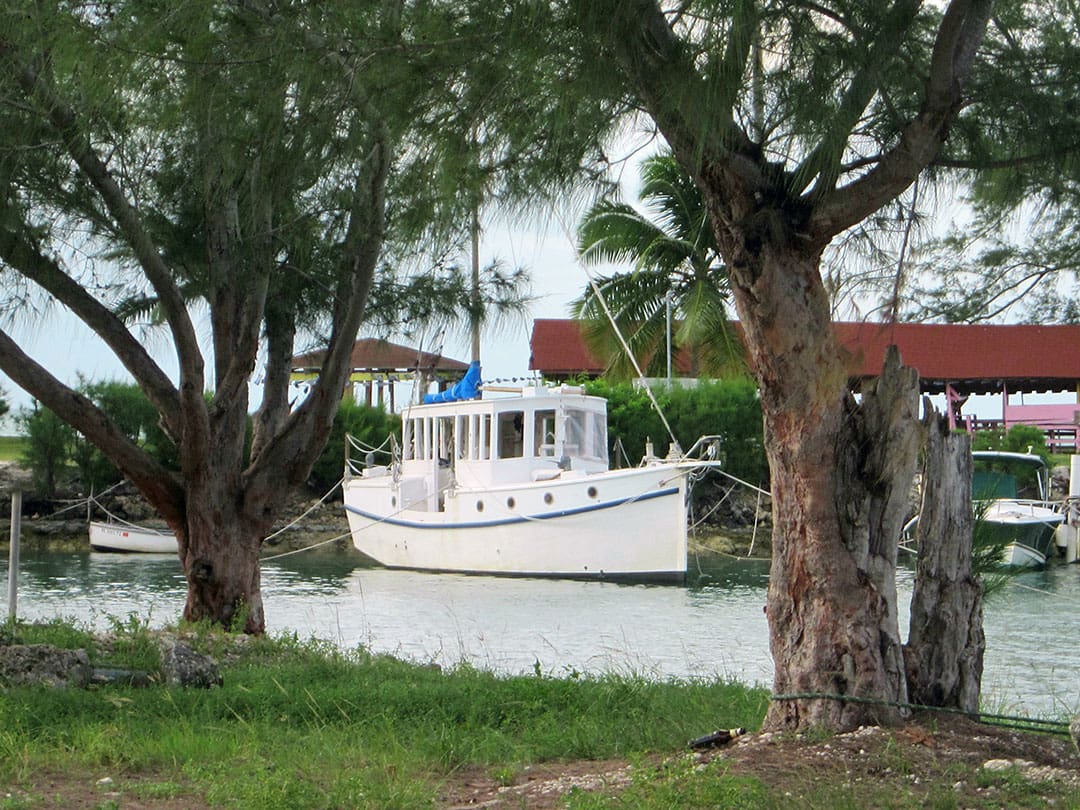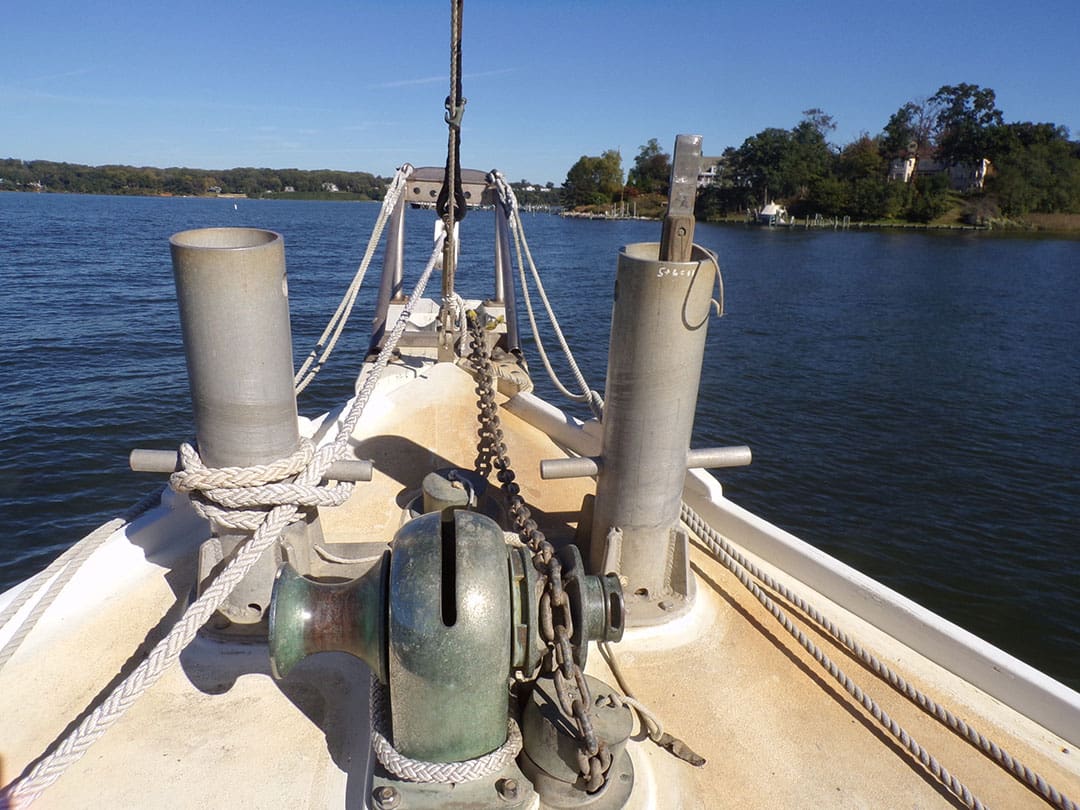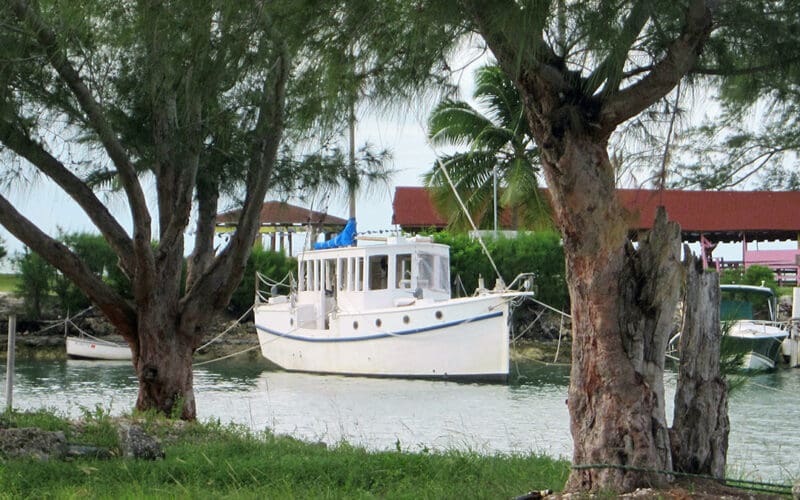
Liveaboards and cruisers since 1997, Rudy and Jill Sechez built both of their cruising boats, first a 36-foot wooden cutter, and later, their current 34-foot sail-assisted wooden trawler Briney Bug, which they designed themselves. The Sechezes are interesting because they are something of an outlier among modern liveaboard voyagers in the way they stress radical simplicity. In their approach to voyaging, they strive to operate their vessel with a minimum of systems on board.
Their cruising grounds are primarily Florida and the Bahamas. Over the years they have also traveled the east coast of the U.S., some of the Great Lakes by way of the Hudson River, the Chesapeake Bay, the Tenn-Tom into the Tennessee River, and the Gulf Coast to Louisiana, many of these places more than once, and the majority of the time, anchoring. Through the years, Rudy and Jill have had many experiences anchoring in diverse conditions, including many hurricanes and storms.
Their book, Anchoring, A Ground Tackler’s Apprentice, published by Waterway Guide Media, LLC, is available from Waterway Guide Ship Store.
Rudy and Jill are anchoring consultants, providing onboard, hands-on sessions, to help those who want to improve their anchoring skills. They also offer consultations and seminars. Read more at: anchoringtraining.blogspot.com/, or email them at: rudysechez@gmail.com

ride on a
friend’s boat.
OV: What prompted you to go voyaging?
J&RS: In addition to the adventure, we wanted the ability to travel at our pace, doing so in a venue that we enjoy. We also saw it as a way to a simpler lifestyle, stepping away from being tied to things that we found less than fulfilling or satisfying.
OV: How much preparation did you do before setting off?
J&RS: Ultimately, setting off involved a lot of preparation. We had some small power and sailboat experience. Over a period of several years we took Coast Guard Auxiliary, Boating, Power Squadron and navigational classes, as well as a self-study course on celestial navigation.
We also read a significant number of books and articles about cruising and outfitting, seamanship, weather and navigation, among other topics… we soaked up as much traditional information as we could find.
It was during this period that we built our first cruising boat, a 36-foot, carvel-planked cutter, a 2.5-year project. Following this build’s completion, we took a couple more years sailing locally to gain some familiarity and skills, fine-tuning our boat.
The final step was selling our land possessions and anything else that we would not need on the boat. After we cruised several years, we then stopped to design and build our current boat, a 34 foot, carvel-planked, sail-assisted trawler, a four-year project.

OV: What was it about your boat that prompted you to choose it?
J&RS: We wanted to stay with a solid, traditional design with the overriding requirement that it be as simple, seaworthy, and inexpensive as possible but without a foot more in length than required. We chose wood because we enjoy working with that medium.
We were and still are able to cruise inexpensively, trading time for money, and adapting to the seasons as they change. We kept all systems as simple as possible and independent of one another.
A few specifics on the design include: a full-length keel, allowing the boat to track straight; a big rudder, providing low speed maneuverability; heavy displacement with a good metacentric height, which affords a comfortable motion; full displacement, providing for tons of storage; and, being laid out strictly for two people, allows for plenty of people-sized furniture and spaces.
The 42-hp Westerbeke 42B diesel engine allows us to go farther with less fuel than if we had powered our boat with a much higher horsepower engine. We also chose a simple, home-buildable rig and sail plan as a “get somewhere” back-up system should the single engine fail; plus, it gives a nice one-knot boost when motorsailing.
OV: How do you generate electricity onboard? Any other method in addition to the propulsion engine such as a genset, wind or solar?
J&RS: The only electricity that we’ve required is to recharge our computer and cell phone, accomplished using a relatively small inverter that is wired to our start battery.
A few years ago, when we were using our computer to write our book on anchoring, our battery would consistently run down, so we installed a 40-watt Genasun GV-5 solar panel that keeps the battery topped up.
Otherwise, all of our needs are handled by propane, diesel, kerosene, with our radios and flashlights using dry-cell batteries. We do carry a small portable generator should the engine’s start battery ever have too little charge to start our engine.
OV: What type and capacity batteries do you have?
J&RS: Since we essentially have a non-electric boat, we only have one group 31 battery, the engine start battery.
OV: Do you have a WiFi network on your boat?
J&RS: Our WiFi is provided through a Jetpack (mifi) device. However, when we go “foreign” we discontinue service to both our phone and WiFi, doing without, then reestablishing service once we return to the states.
OV: Do you use satcom? Do you have an HF SSB radio, VHF radio?
J&RS: We have only a dry-cell battery operated SSB receiver from which we get high seas weather forecasts; locally we rely on NOAA reports and visual observations.

OV: What type anchor do you use?
J&RS: For more than 15 years we cruised with only a 55-pound SuperMax anchor as our main bower, and a 70-pound Luke (fisherman-style) anchor for heavier weather or when in grass. For convenience, and as our financial situation improved, we added a Fortress FX 37, then a Fortress FX 16. Eventually when we found a 100-pound Luke anchor at a good price we added it to our inventory. Our main bower is attached to 250 feet of 5/16-inch high-test chain which runs through a manual windlass. The other anchors each have 7/8-inch by 250-foot nylon rodes. Our 100-pound Luke anchor sports 300 feet of 1 ¼-inch nylon rode. In addition to our 7/8-inch by 50-foot long dock lines, we have several 200- to 300-foot coils of 7/8-inch nylon line that can be used in any manner that is necessary.
To cover all contingencies, we’re outfitted with all of the odds and ends that might be needed to anchor in any situation.
OV: What’s the most important maintenance task you perform on the boat?
J&RS: The most important maintenance is directed at the engine, following the intervals prescribed by the manufacturer; this maintenance schedule is followed religiously.
We carry at least one spare for every item on the outside of the engine, a spare head gasket, plus all other gaskets, sealants, and tools necessary to effect replacement of any of these items. We also carry basic diagnostic equipment such as a multi-meter, coolant system pressure test kit, and a cylinder pressure test kit.
For non-engine items, we carry a spare or service kit for each, replacing or rebuilding each when they reach the end of their service life or when they begin to show evidence that they are failing.
OV: What gear do you plan to add next to your boat?
J&RS: We have no plans or needs to add anything to our boat at this time other than replacing items as they are consumed into service.
OV: What are your future voyaging plans?
J&RS: This current year, we plan to cruise in the Bahamas, late spring and early summer, then return to Florida. We have not yet made our travel plans past that point.

